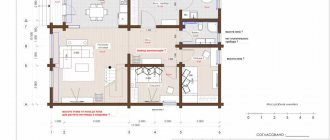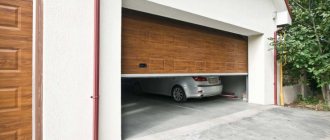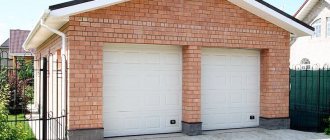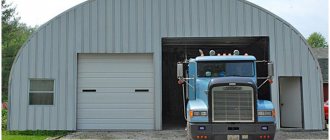The layout of residential development and the placement of ancillary buildings on the territory are determined by construction standards and rules. Many car owners believe that on plots near private houses they can build a garage structure anywhere. This is wrong. To erect permanent buildings on land for individual housing construction and personal subsidiary plots, it is sometimes necessary to obtain permission. It is necessary to comply with the regulations for the construction of a garage on the site.
Do you need documents to build a car garage?
If the car owner intends to use the garage only for personal purposes, there is no need to apply to the local administration for permission. Regulated by Art. 51 of the Town Planning Code of the Russian Federation.
If the arrangement of a garage structure is intended for doing business, contact the town planning department of the local municipality with an application. Specialists will visit the site to determine whether construction work can be carried out. The landowner must present:
- Title documents for land.
- General plan of the building.
- Relief plan.
- Scheme of engineering networks.
When a garage box is built on your own land for personal use, fire and sanitary requirements are strictly followed.
Useful video: we make a blind area in front of the garage according to all the rules
If you decide to make a platform in front of the garage with your own hands, you will need not only instructions and recommendations. It is best to supplement the information received with visual material. Watch the following video clip.
The design of the blind area is discussed in detail here. It is quite possible to cope with such work on your own, to do everything as efficiently as possible. The main thing is to remember all the important points and act carefully.
Be careful: if you manage to make the right entrance to the garage, it will provide additional comfort and safety.
Some subtleties of the issue
Is it possible to build a car garage on an area bordering a road?
The requirements should not be violated. A car garage built on the border with the roadway may cause disputes from neighbors. They can prove that the structure would prevent a fire truck from turning around to approach them. The court will order the dismantling of such a building.
This is interesting: 3 meters indentation from the border of the site
Possibility of erecting a box on the border with the alley
According to the Code of Rules 42.13330.2011, any auxiliary outbuilding (including a car garage) located in the local area must be located from the border of the site, maintaining a distance of 1 meter. The joint venture allows outbuildings on neighboring territory only with the consent of the neighbors. Otherwise, the court will make a decision to demolish the building if the owner does not move it 1 meter from the border of the UZ.
If the owner of a nearby house has violated the requirement, they file a statement with the fire department outlining their claims. Be sure to make a reference to the Federal Law “Technical Regulations on Fire Safety Requirements” No. 123 of July 22, 2008.
What the law says
According to building regulations, the garage must be located at least one meter from the neighboring territory.
According to fire safety standards, the distance between buildings made of non-flammable material must be at least 6 m. If the buildings are wooden, then the distance between them must be at least 10 m.
It is also necessary to remember about the red lines that delimit the public area from the site.
Public areas include lines of various communications, roads, sidewalks, etc. A distance of at least 5 m must be maintained between the garage and the red line.
How to draw up a statement of claim to the court for recognition of ownership of a garage?
How to register ownership of a garage in a cooperative, read here.
How to get free legal advice by calling the hotline around the clock, read the link: https://novocom.org/konsultaciya-yurista/goryachaya-liniya-yuridicheskoj-pomoshhi-besplatno-po-telefonu.html
What to do if your neighbor's garage has encroached on your property
Many people face the problem when a neighbor's garage is partially located on their land. This happens when buying real estate. If the owner has completed all the documents for the purchased house and plot and is confirmed by an extract from the Unified State Register, he has the right to demand that his neighbor dismantle the garage box on a voluntary basis. If the owner of the neighboring territory does not remove the structure within the specified period after receiving a written notice, they file a claim in court.
In Russia, documents have been adopted regulating the correct development of plots that are privately owned by citizens. If you strictly follow all legal standards when building a garage on a plot of land, you will not have any troubles with the authorities and neighbors due to improper placement of the facility. Building codes and regulations are regularly updated and supplemented with new construction techniques. They need to be studied before carrying out work.
Construction documents
Despite the fact that you do not officially need permission to build a garage on the territory of an individual housing construction, sometimes it will not be a bad idea to obtain one. In case of conflict situations, the document will be especially useful. The permit is issued by the local administration after submitting a site plan indicating all buildings and the garage, including.
On paper you need to indicate their location on the site, square meters, location in relation to each other, as well as to the neighboring site. The plan is submitted to the architecture department, then the developer receives a decision.
If obtaining a permit is not always a mandatory point, then a capital structure must be registered. An unregistered garage can become a hindrance when selling a plot.
After building the premises, you need to contact the Rosreestr office and provide a package of documents: a certificate of ownership, a general plan of the site and a detailed plan indicating the details - the size of the garage, its location, etc.
After reviewing the documents, the construction will be registered or a refusal will be received on the basis of violations in case of non-compliance with the standards. When returning documents, the reason for refusal must be indicated; after correcting the problem, you will be able to resubmit the documents.
At what distance from the fence can a garage be built: SNiP norm and law
When placing a permanent garage for your favorite car on the site, you need to take into account existing standards. To exclude claims from government agencies and neighbors, you should know at what distance from the fence you can build a garage. It is necessary to determine in advance the list of permits and the procedure for constructing buildings of this type. This will help to avoid complaints and problems upon completion of the construction of a garage next to the fence due to non-compliance with distance standards, rules and legal requirements.
Entry areas of different types
Let's consider what points you need to pay attention to when arranging the area in front of the garage in different cases.
- A private house. Here you have freedom of action. The most important thing is to ensure that the passage is always free. You should not be disturbed by other buildings. You also need to meet one more requirement: the road must be clearly visible to you when you leave the garage.
- Basement. Here it is necessary to maintain a slope: approximately 20 degrees. It is important to make the platform safe so that it does not slip. A good solution is to additionally protect it from precipitation with a canopy.
- Ramp in a garage cooperative. Here it is advisable for you to enter together. It should be level, with a slight slope and drainage system. The base can be made approximately 15 cm deep.
Regulatory restrictions
The construction of main and auxiliary buildings must be carried out without violating building codes and regulations (hereinafter referred to as SNiP), which take into account technical, legal and economic requirements in relation to architectural surveys and urban planning.
In order to be able to register a new building as an object of real estate owned, it is necessary to obtain the appropriate permission.
An exception is represented by a combination of the following circumstances:
- Construction of a garage is not associated with the desire to make a profit from rental activities, vehicle repairs and other things.
- They plan to install the box on land owned by the owner, allocated for housing construction or non-profit gardening activities (SNT or dacha cooperative).
- The box does not have a foundation, for example, a metal one, therefore, it does not belong to capital construction projects.
In all other cases, the owner of the site is obliged to contact the architectural department of local authorities, submitting the following documents:
- a written statement with mandatory information (from whom, to whom, circumstances and essence of the request);
- a copy of the identity document of the owner of the land plot;
- document confirming land ownership;
- topographic reference to the area;
- cadastral plan of house construction and adjacent territory;
- technical documentation with BTI assessment information;
- scheme for entering communications into the housing construction area;
- project.
Having received the application, the official is obliged to issue a receipt to the applicant stating that the documents have been accepted for consideration. The decision on whether it is possible to build a garage in the declared location is made within ten working days. In practice, this procedure takes longer.
If a negative decision is received, all documents must be returned. The applicant has the right to re-submit a petition to the same body after changing the construction plan or may appeal to the courts to appeal an administrative, in the opinion of the applicant, unlawful refusal.
What types of objects are there?
Some features of the implementation of formal procedures depend on what type of building was erected on the territory near the residential building . The following types of structures are distinguished:
- Complex - they are part of a single building, consisting of a large number of car boxes.
- Capital - buildings with a solid foundation, for the construction of which expensive and high-quality materials are used. Such garages are considered as full-fledged real estate objects.
- Metal garages acting as free-standing structures. Metal structures can be easily disassembled and moved to another location.
- Parking garages are special semi-open areas intended only for parking vehicles.
Documentation is most often drawn up for the first 2 types, since they are more expensive real estate and it is beneficial for the owner to prepare it. It makes no sense to officially register cheaper designs in most situations.
Removal from objects
Obtaining a building permit largely depends on compliance with SNiP requirements in the construction project, in particular, whether the minimum permitted distances to courtyard buildings, neighboring houses and infrastructure facilities are observed during the construction of a garage.
SNiP norms for 1997 prescribe the following for outbuildings, which include car premises:
- distance from residential buildings if the garage is attached - 3 m;
- distance to other outbuildings (barn, separate attic, etc.) from 1 m;
- distance from the fence to the garage from 1 m;
- the sector to the bush is at least 1 m;
- distance from trees of moderate growth from 2 m;
- the distance between the extension and tall trees is from 4 m;
- the distance to the neighbor’s residential building is at least 6 m;
- to the “red line” (the border of private households and municipal land) more than 5 m.
A garage cannot be built close to a fence. It is necessary to make 1 meter indentations from the neighbors' fence.
Restrictions on the specific placement of the car box and the functioning of its individual structural elements:
- If the garage is attached to the house, then the distance to the nearest building should be at least 3 m.
- When placing the box with the gate facing the street, a distance of 3 meters from the road must be maintained.
- The distance from the garage to the roadway in villages and cities is at least 5 m, while the distance is calculated from the base of the building or roof if its protrusion exceeds 0.5 m.
- If one of the sides is adjacent not to the neighbor’s fence, but to an alley, then the distance to the road should be less than 3 m.
- Installation closer than two meters to a power line support is not allowed.
Violation of SNiP regulations in the event of unauthorized construction is not grounds for initiating administrative or criminal proceedings. But the initiation of a complaint by a neighbor or an investigation into the consequences of an emergency due to the fault of an attached building will lead to the court making a decision precisely in accordance with SNiP.
Red line
The previously mentioned property line designation of land is an important factor in determining the feasibility of construction in the selected location.
As a rule, on state territory near private houses there are lighting poles, information signs, etc.
Main gas supply lines, water supply and drainage communications are hidden underground. They are combined with pedestrian paths, and in many cases, highways and local roads.
Construction restrictions make it possible to ensure unhindered 24-hour access to life support lines for the population. The master plan (GPZU) of any settlement contains the exact location of the red lines. If in the documentation submitted for approval the distance from it to the box is less than 5 m, then a negative answer will most likely be received.
There is a high probability that if the construction of a building was carried out without taking into account the distance to the red line, the owner will be forced to demolish it by court decision.
Garage arrangement
Construction permit.
Depending on the preferences of the owner of the site, as well as based on financial and territorial possibilities, a garage can be built in several ways - separately from a residential building or nearby, while building it into the house or making an extension to the side wall.
If the most suitable option is a separate room, then do not forget to maintain the required distance from the residential building.
The best option is to build near the red line, but not on its border, and taking into account other SNiP recommendations. A nearby building will be a hindrance for other cars on the roadway, since there will likely be passengers getting on and off in front of the garage or stopping to open the gate.
This point will be especially inconvenient if the gate is swinging, since each time you enter and exit you will have to linger on the road. In addition, it is imperative to ensure easy passage for emergency services.
Features of the neighborhood with wooden buildings
The proximity to a farmstead where a wooden residential building is built increases the mandatory distance to 15 m. At the same time, the right to agree with the owner on reducing this distance is retained. Consent is drawn up in writing and certified by a notary.
The same procedure for neighbors to resolve the issue applies to brick buildings, if it is necessary to build a room for a car at a distance of less than 6 m. A prerequisite for receiving a positive answer from a neighbor is to ensure sufficient fire safety measures.
This is interesting: Setback from the border of the individual housing construction plot
To do this you need:
- install an external shield with recommended fire-fighting accessories;
- place a fire extinguisher in the room;
- ensure that the room is not heated;
- place the electrical power supply distribution panel outside the building;
- equip the electrical panel with an automatic load switch;
- trace the wires in a protective metal sleeve;
- equip lighting devices with factory shades.
If the above recommendations are not followed, you may not only lose the opportunity to resolve the issue peacefully, but also aggravate the situation as a whole. Thus, guided by Article 304 of the Civil Code of the Russian Federation, the owner of a neighboring plot may demand that construction and operation be brought into compliance with fire regulations. Failure to comply with the permitted construction distances is a direct possibility of fire spreading.
Fence construction procedure
Coordination of site boundaries
Paradoxically, the process of arranging a fence itself is far from the main difficulty that awaits you. The approval procedure is much more labor-intensive, and in order to avoid mistakes, we recommend that you study this section very carefully.
Development plan with boundaries for approval
Beginning work on the construction of a fence involves familiarizing yourself as fully as possible with all the documentation you have for the land plot. The key documents here are the land cadastre (the cadastral plan attached to it is important) and the boundary plan.
After studying the documents, it is necessary to hold a meeting of the owners of the plots bordering yours. During the meeting, you should voice your plans for the construction of residential and non-residential facilities, as well as for the construction of fences. Suggestions or comments may be made. If these comments comply with the requirements of SNiP, they must be taken into account.
Structure of the boundary plan
A boundary approval act must be signed, which contains:
- Graphic representation of the boundaries of the site.
- Signatures of the owners of neighboring plots of their statements about the absence of claims to the construction of the boundary line.
The act is drawn up by a cadastral engineer and certified by him. If disagreements arise about where the fence should be located on the ground, geodetic services should be involved in drawing up the act.
Note! The cost of geodetic services is very significant, so issues of coordinating the placement of buildings and fences should be resolved “amicably” with neighbors.
Recommendations for choosing a site for construction
In order to have fewer questions when coordinating documentation with the architects of the local administration, the construction of a capital box should be planned taking into account the following:
- If the building is located inside a courtyard area, then the entry of a car should not be accompanied by additional maneuvers.
- There should be enough space on the inside of the entrance gate to lock the garage door.
- The entrance to the garage, if it is adjacent to the street, must be designed to provide sufficient visibility for the safe maneuver of exiting vehicles.
- Opening the gate should not interfere with the movement of pedestrians and passing cars.
- The building should not block the access of light to the neighbor’s vegetable garden or garden if it contains low-growing varieties of trees.
- Water drainage from the roof must be directed to the territory of your site, both from the roof and along the ground using a ditch.
- Planting your own trees is carried out taking into account the requirements of SNiP.
- If you decide to build a garage adjacent to the house or allocate a basement floor for it, then all fire safety standards must be met. They relate to the equipment of the room with a hood, fire equipment, and a fire alarm.
If the garage is located in a private house in the basement, then fire safety rules allow parking and storage of vehicles running on liquid fuel there.
About garage sizes
At the design stage, the internal dimensions of the garage should be provided to ensure minimal comfortable and safe use. They can be:
- on both sides of the car - 0.8 m;
- if there are columns - at least 0.6 m;
- from the trunk and hood of the car - at least 0.7 m;
- with impressive parking dimensions, when parking cars one after another - 0.6 m;
- if parallel parking of two cars is provided, then a width of 1.6 m and a length of 1.4 m are added to the standard dimensions.
About the ceiling height. In accordance with SNiP standards, the ceiling height is taken to be the distance from the surface of the floor covering to the maximum protruding lighting fixture or communication element. The safety gap to the car cannot be less than 0.2 m.
Following the recommendations will not only help you comfortably use the room for its intended purpose, but also in a critical situation.
For example, in the event of a fire, this will allow the evacuation of vehicles and stop the spread of fire.
Construction standards violated
If the garage was built without complying with building codes, the neighbors can go to court. Basically, he makes a decision that allows the violations to be eliminated without demolishing the building, since the demolition of the building may incur more serious losses, in contrast to the inconvenience caused by the construction of a garage in unacceptable proximity.
For example, if the plaintiff complained that his property was flooded with water from the garage roof during rain, then the court decides to increase the amount of storm drains. Violation of the meter zone from a neighbor's house is also not always a reason for the garage to be demolished.
IMPORTANT! If such circumstances exist, the court may reject the claim due to its insignificance. The judicial authorities will justify this decision by the fact that construction standards are advisory in nature.
Thus, the place where a garage can be built on the site is regulated by regulations. It can be erected in violation of SNiPs, but only on one condition: that there is written and recorded consent of the neighbors. Otherwise, not only they, but also the local administration of the locality may file claims.
If there is no consent from the neighbors, then you will have to measure 5 meters from the fence and plan a site for the construction of a garage at this place. To be on the safe side, it is advisable to add another half a meter, since if at least one corner is closer than 6 meters from neighboring buildings, in the event of a conflict with neighbors, the garage may be demolished.
Litigation
Clarification of relations between neighbors in the courts is an extreme measure used in cases where it is impossible to find mutual understanding. But if it is not possible to dispose of your land to build a garage due to unfounded claims, then there are no other ways to prove your case.
To consider the case in court, the plaintiff prepares and submits a statement of claim accompanied by title documents of a housing nature. Their list duplicates the necessary papers for approval of the project by the administration architects.
The plaintiff also sets out the circumstances and subject of the illegal claims, methods and means of preventing the realization of rights. The statement of claim is supplemented with evidence in the case in the form of photographs and video materials.
Before preparing a statement of claim, you should make sure that there are no violations on the part of the plaintiff, and that the norms for distances from residential and auxiliary premises are met. Otherwise, it will not be possible to count on a positive decision.
Filling a slab in front of a 3 x 2.5 garage: tips from car enthusiasts
Let's consider the advice of car enthusiasts regarding durable pouring of the area in front of the garage with dimensions of 3 by 2.5 meters. This is what the garage guys offer.
- You can dig a trench to the freezing depth. Then 300 grade concrete is poured straight from the mixer. You will need to fill approximately 16 cubic meters. This is a good method that ensures longevity.
- A good solution is a reinforced platform. The soil is removed and the earth is compacted. Then geotextiles and a sand cushion 20 cm thick are laid. The reinforcing mesh is laid, and then concrete is poured.
- Some car enthusiasts even make a platform with piles. 6 piles are taken and installed below the freezing level. They are connected by a strip foundation, and a concrete slab is poured on top.
As you can see, there can be a lot of options.
How much do you need to step back from the fence when building a garage?
Similar situations often arise that have simple solutions, including:
- The owner built a garage close to the fence, he doesn’t know what to do. The only correct decision is to fulfill all fire safety training requirements and come to an agreement with the neighbor, documenting the absence of objections.
- What distance should you retreat from the fence when building a garage if the red line is 9 meters away? With such a distance from the property line of the land, the minimum distance between the garage and the fence must, by law, be at least 1 meter.
- If a neighbor built a garage from the fence, without retreating, violating the 1 meter standard, and the side wall is located close to the fence, what should you do? If construction took place without approval, then you need to file an application with the court.
- How much should you step back from your neighbor's house if it is wooden and there is no fence around the property? You should focus on the recommended standards - 15 meters. You can install an iron or brick garage after agreement with your neighbor.
- Settlement in the household after its acquisition occurred later than the time the neighbor built the garage; it turned out that the distances were maintained, and the light did not enter the yard. The courtyard is not a vegetable or garden area. Distances have been maintained, and there is nothing to file claims in court for. In this case, all that remains is to redevelop your site as much as possible.
Every year the country's legislation is improved, and SNiP requirements undergo changes. In this regard, to obtain objective information in each specific case, you should seek advice from practicing specialists. This also applies if difficulties arise when independently preparing a project for a future garage.
How many meters to retreat when erecting an individual building on a site is shown in the video below.
Choosing a place
The first thing a car owner needs to do is choose the most suitable and convenient location for a garage. In this matter, you need to take into account the size of the room, depending on the number of cars or items that will be stored inside in the future.
There are many factors that influence the comfortable and proper use of the premises:
- the location must correspond to the dimensions of the machine;
- ensuring a short check-in - a significant distance of the garage from the road will entail additional costs for arranging the passage;
- proximity to communication lines - the design takes this fact into account, since lines passing under the premises will lead to its dismantling in case of emergency;
- the building should not shade the neighboring planting during daylight hours;
- drainage of water from the roof is done on your own territory;
- You should ensure a distance of 2-4 m between the garage and large trees.
Basic fire safety requirements for garages
It’s good when the site is large and convenient. Review the projects, choose the one you need and place buildings, gardens, and yard according to your taste. It is more difficult to equip a small and not very convenient area. It does not matter whether a summer house or a house for permanent residence will be built, such buildings as a barn, garage, summer kitchen, gazebo are always desirable and necessary on private property.
This is interesting: How to pipe gas to the property line for free
Monolithic brick fence combined with a garage
A rational approach to site planning allows you to save space and significantly reduce the cost of landscaping. One of the options for saving space is projects of fences combined with a garage. This method of placing a building has its advantages and disadvantages, its fans and opponents.
The advantages of joint construction include:
To create a single yard style, a garage and a fence with common boundaries must be made of the same material, in a common style.
Projects for the joint construction of a fence and a garage have an option when a common wall with a gate facing directly onto the street becomes common. In this case, the garage door and the gate are made of the same materials, the same color and design.
The second option is a common side wall, and the garage door is located at some distance from the fence gate. In this case, the costs of building two gates are added, but it is possible to park the car in the yard without a garage.
The garage fits best into a fence made of brick or stone; in this case, they create a single picture. Finishing of both the common wall and the rest is carried out with the same materials. A rich look is created by gates with forging elements.
Another excellent material for this type of placement of buildings is corrugated sheeting. Fences made from it have already become firmly established, and garage designs made from corrugated sheets are an innovation, but quickly adopted by car enthusiasts.
This is the simplest material for building both a garage and a fence on your own, and is also affordable.
Preparing the base for pouring a concrete pad
Before pouring a concrete area for parking a car in the yard, the base must first be prepared: mark the boundaries of the future parking lot, as well as clean and level the surface.
The main stages of constructing a concrete platform:
- preparation work;
- foundation organization;
- formwork installation;
- reinforcement;
- preparation of solution;
- concreting.
Instead of a garage - a canopy to the fence
A common wall makes it possible not to build a permanent structure, but to attach a covered canopy to a high fence. Building a carport is advisable if you have several cars and it is not possible to build a large garage.
Option for a canopy to the fence instead of a garage
Covered parking within the yard can be added to the fence when it is installed, or can be added later. Such a canopy can be placed either immediately after the gate or at any convenient distance. To prevent water and tree branches from getting on the car during heavy rainfall or wind, it is better to plan the parking lot on the side most protected from the wind.
As a material for covered carports, you should choose one that suits your financial capabilities, the design of the yard, and does not create difficulties during installation.
What could be easier than building a garage or erecting a fence? Nothing until you start construction. This is where the questions begin: what distance from the fence to the garage can you choose? Norms? SNiPs? Rules? Calm down, we have prepared a detailed answer about this (and more) in this publication.
How to make a parking lot with your own hands, step-by-step instructions
Even those who have no experience in this can make a car parking lot on their own property with their own hands. The main thing here is to know the sequence of necessary work and strictly follow it. To install a concrete parking lot you need:
- prepare the surface;
- install formwork;
- strengthen the structure by reinforcement;
- pour concrete.
Important! If cracks appear in the parking lot during use, they are rubbed down with ordinary cement mortar.
Surface preparation
Preparatory measures for organizing parking for a car in the yard include:
- marking the boundaries of the area where concrete will be poured;
- removal of weeds and debris;
- preparing a pit - excavating soil at least 20 cm deep to get rid of the roots of weeds and prevent their subsequent germination;
- installing a sand cushion of about 15 cm, which must be leveled, thoroughly compacted and slightly moistened;
- filling a crushed stone layer of at least 10 cm, leveling and compacting;
- geotextile flooring to prevent the pillow from spreading under the load from the solution.
Important! It is necessary to ensure that the site slopes in one direction (or two) so that water from washing the car or rain drains away.
Installation of formwork
Before pouring concrete into the future site, it is necessary to arrange removable formwork to create smooth edges. This can be done using plywood, iron, boards, curb stones or plastic, fastening the fences together. The formwork is installed before the sand cushion is filled in to prevent the solution from leaking out. To level the solution, it is recommended to use beacons with a pitch of 50 cm, which are suitable as metal pins. Notches are made on them to determine how smooth the surface is, and a cord is secured between them along the notches. The check is carried out at the building level.
Reinforcement
To increase the strength of a concrete platform, it is necessary to perform reinforcement. The reinforcement frame is a mesh of metal rods 0.8-1 cm in diameter, fastened with wire. The reinforcement process consists of laying the frame on a layer of sand and crushed stone.
Filling the parking lot
The prepared concrete solution is poured onto the site and carefully leveled along the beacons. You can level the composition with any flat strip or special tool. Filling is done in one go, so when mixing, you need to make a volume that will be used up immediately.
Important! Do not pour the solution when the outside temperature is below 5°C.
Garage on the property: norms and rules, customs and habits
The construction of low-rise buildings today is not subject to strict construction control and regulation. The homeowner has the right to independently determine the parameters of the house and outbuildings, the location of technical services, the garden, the distance from the fence to the garage. And yet, when solving planning problems, the owner of the site must take into account some norms of Russian legislation. At least in order not to rebuild later, when it turns out that in some way the owner of the site and the house infringed on the rights of the neighbors. This also applies to the rules for choosing a location for a garage on the site.
Our store website provides a larger selection of all components.
We do concreting correctly
Now we’ll find out exactly how to properly concrete the area in front of the garage. Remember the recommendations and step-by-step instructions.
- The soil is removed to a depth of 40-50 cm. The pit must correspond to the size of the screed.
- The first layer is sand. It is compacted and watered.
- Then small gravel is laid.
- The formwork is made from boards. Boards 25 mm thick are suitable. The formwork is made evenly and secured. The boards need to be lubricated with a special composition so that they can be easily removed later.
- Insulation is placed on the crushed stone. The best option is polystyrene foam 5 cm thick.
- The concrete layer is poured.
- Then the reinforcing mesh is laid.
- Then you can pour the finishing concrete screed.
Remember that the screed must be leveled and then covered to prevent damage during drying. Such a concrete platform stands for about two weeks.
Compliance with safety regulations
The first regulatory document that you need to pay attention to is the law of the Russian Federation dated December 30. 2009 No. 384-FZ “Technical Regulations on the Safety of Buildings and Structures” (hereinafter referred to as Law No. 384-FZ). Basic safety principles relevant to low-rise and homestead construction. Such objects include a garage.
Principle 1. Buildings and structures should not pose a threat of mechanical damage. Buildings and structures should not threaten people with mechanical destruction and injury as a result of these destructions. There should be no threat of mechanical damage to other buildings and engineering structures. As an example, we can consider a situation where a neighbor installs his garage in such a way that the garage door, when opened, destroys the fence of your property. The situation, at a minimum, leads to a scandal between neighbors, and at maximum to a trial.
Principle 2.
During operation and during the construction of houses and premises for economic or technical purposes, fire safety rules must be taken into account. Today, the regulatory approach to low-rise civil construction has been weakened. The fire danger of an object (if it is used for business) in the private household is determined by the owner himself. It is necessary to take into account the rules (SP 42.13330.2011, SNiPs: 2.07.01-89, 02.31.2001, 02.30.97, 2.01.02-85) and fire safety rules established by technical regulations (law dated 07.22.2008 No. 123-FZ, hereinafter referred to as Regulation No. 123-FZ).
Principle 3.
During the construction and operation of buildings, outbuildings (including garages) and engineering support structures, it is necessary to comply with sanitary safety standards and not use materials or technologies that pose a threat to human health.
Principle 4.
Environmental consequences must be taken into account. It is prohibited to harm nature.
Principle 5.
The designs of buildings and structures must be designed for possible natural disasters characteristic of the area where construction is taking place.
Principle 6.
Houses, garages, outbuildings, and structures supporting them should not cause situations leading to injury to people. Houses and outbuildings on the site must be located in such a way as to exclude the possibility of injury to a person.
Principle 7.
Buildings and structures today must be energy efficient. Compliance with this principle (use of modern energy saving technologies) allows the owner to save on operating costs. The owner saves his money and saves natural resources and energy on a national scale.
Today there are no special requirements for buildings such as a garage for one or two cars on the territory of a private household. Compliance with these principles makes it possible to arrange all outbuildings on the site as conveniently as possible, to provide for possible emergency and non-standard situations as much as possible, and to maintain good neighborly relations.











